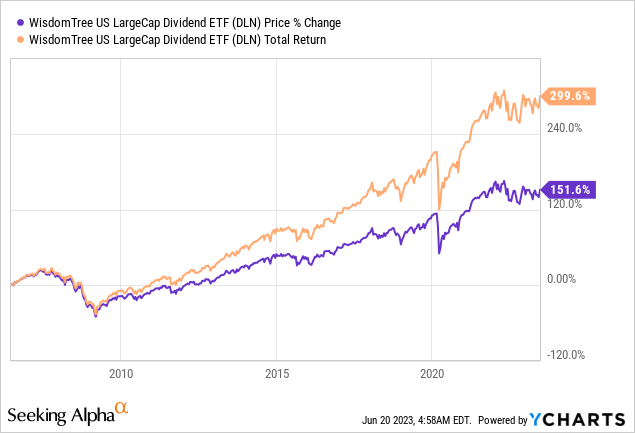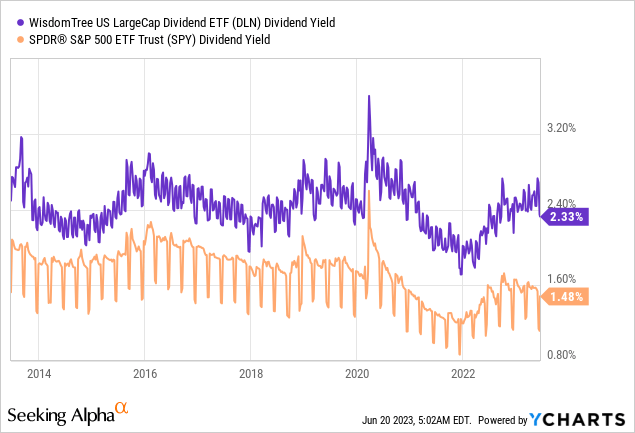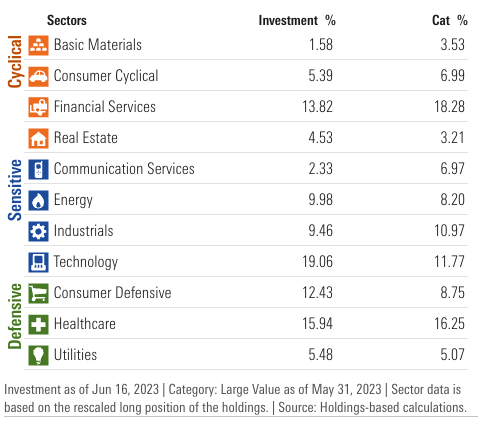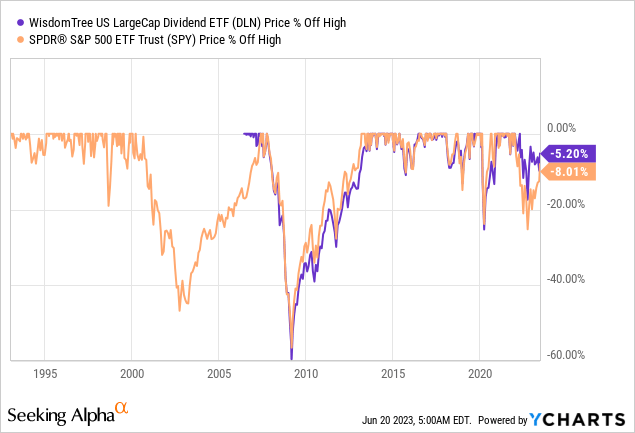Introduction
Some investors prefer investing in dividend funds as they seem to provide better yield and may even provide better downside protection than the broader market. Is this really the case? In this article, we will analyze WisdomTree U.S. LargeCap Dividend ETF (NYSEARCA:DLN) and provide our insights and recommendations.
ETF Overview
DLN invests in large-cap dividend stocks in the United States that have generally increased their dividends consistently. The fund also offers better yield than the S&P 500 index. However, it does not offer better downside protection and has inferior long-term returns. Therefore, we think investors are better off investing in the S&P 500 index instead.
YCharts
Fund Analysis
DLN invests in stocks that have generally increased their dividends consistently
We like the fact that most stocks in DLN’s portfolio are able to consistently grow their dividends. As can be seen from the table below, its top-10 holdings have consistently increased their dividend for more than 10 consecutive years. These top-10 holdings represent about 26% of the total portfolio.
|
10+ Consecutive Years of dividend growth |
% of ETF |
|
|
Microsoft (MSFT) |
Yes |
4.47 |
|
Apple (AAPL) |
Yes |
4.44 |
|
Exxon Mobil (XOM) |
Yes |
3.55 |
|
Chevron Corp. (CVX) |
Yes |
2.35 |
|
AbbVie (ABBV) |
Yes |
2.13 |
|
JPMorgan Chase (JPM) |
Yes |
2.06 |
|
Coca-Cola (KO) |
Yes |
1.78 |
|
Merck (MRK) |
Yes |
1.77 |
|
Johnson & Johnson (JNJ) |
Yes |
1.76 |
|
Broadcom (AVGO) |
Yes |
1.75 |
|
Total |
26.06 |
Source: Created by author
Better yield than the broader market
DLN provides an attractive dividend yield of around 2.3%. This yield is better than the broader stock market. For example, the S&P 500’s dividend yield of about 1.5% is more than 80 basis points lower than DLN. As can be seen from the chart below, in the past 10 years, DLN has always had a higher dividend yield than the S&P 500.
YCharts
DLN also has higher exposure to defensive sectors
DLN has a high exposure to defensive sectors. As can be seen from the table below, consumer defensive, healthcare, and utilities sectors represent about 12.4%, 15.9% and 5.5% of the total portfolio respectively. Together, they represent nearly 34% of the total portfolio. In contrast, the S&P 500 index’s exposure to the defensive sector is quite limited. These three sectors only represent about 22.8% of the S&P 500 index’s weighting.
Morningstar
However, DLN does not offer better downside protection than the S&P 500 index
While DLN has higher exposure to defensive sectors than the S&P 500 index, it does not necessarily offer better downside protection. In the past two recessions, the fund has declined more than the broader market. As can be seen from the chart below, in the Great Recession in 2008/2009, DLN declined by as much as 60%. In contrast, the S&P 500 index only declined by about 55%. Similarly, in the 2020 recession caused by the pandemic, the fund has dropped nearly 25%. In contrast, the S&P 500 index only declined by about 23%. Knowing this is important because we are likely in an environment where rates will likely be kept elevated for a lengthy period, and a recession risk is very high. Unfortunately, DLN does not offer better downside risk protection than the broader market.
YCharts
DLN’s exposure to technology sector is lower than the S&P 500 index
DLN’s top 2 holdings are Microsoft (MSFT) and Apple (AAPL). These two technology stocks have outperformed the broader market in the past 10 years and are expected to continue to perform well in the next few years. While the technology sector represents a little over 19% of DLN’s total portfolio, this exposure is low compared to the S&P 500’s 29%. This may be one of the main reasons why DLN has not outperformed the S&P 500 index. As can be seen from the chart below, DLN delivered a total return of 254.4% since its inception in June 2006. While this return is quite good, it still trailed the S&P 500 index significantly as the index registered a total return of 395.6%. The difference in return is more than 150%!
YCharts
Investor Takeaway
As our analysis shows, owning DLN appears to be unnecessary as it does not offer better downside protection than the S&P 500 index. It also does not offer better long-term returns. Therefore, we think investors are better off investing in the S&P 500 index.
Read the full article here












